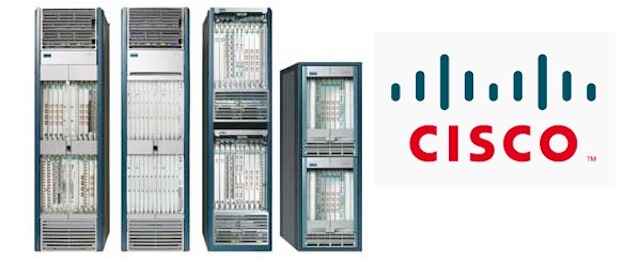
Cisco’s History—Cisco, founded in 1984 by a married couple(Len Bosack and Sandy Lerner) who worked as computer operations staff members at Stanford University, is a worldwide network giant in providing the hardware and software solutions of LAN and WAN. The name “Cisco” was derived from the city name, San Francisco, which is why the company’s engineers insisted on using the lower case “cisco” in the early days. The head office of Cisco Company is in San Francisco and the branches and authorized dealers of Cisco currently exist in most of the countries in the world therefore Cisco hardware devices are used in every region around the globe. The software solution provided by Cisco is the Cisco IOS software based on CLI (Command Line Interface) that is used in Cisco manageable devices.
Cisco was one of the first to sell commercially successful routers supporting multiple network protocols. Classical, CPU-based architecture of early Cisco devices coupled with flexibility of operating system IOS allowed for keeping up with evolving technology needs by means of frequent software upgrades. Some popular models of that time (such as Cisco 2500) managed to stay in production for almost a decade virtually unchanged – a rare sight in high-tech industry. Although Cisco was strongly rooted in the enterprise environment, the company was quick to capture the emerging service provider environment, entering SP market with new, high-capacity product lines such as Cisco 7000 and Cisco 7500.
Between 1992 and 1994, Cisco also acquired several companies in Ethernet switching, most notably Kalpana, Grand Junction and Crescendo Communications which together formed the Catalyst business unit. At the time, the company envisioned layer 3 routing and layer 2 (Ethernet, Token Ring) switching as complementary functions of different intelligence and architecture – the former was slow and complex, the latter was fast but simple. This philosophy dominated company’s product lines throughout 1990s. In 1995, John Morgridge was succeeded by John Chambers.
1996–2005: Internet and Silicon Intelligence: The phenomenal growth of Internet in mid-to late 1990s quickly changed telecom landscape. As the Internet Protocol (IP) became widely adopted, the importance of multi-protocol routing declined. Nevertheless, Cisco managed to catch the Internet wave, with products ranging from modem access shelves (AS5200) to core GSR routers that quickly became vital to Internet service providers and by 1998 gave Cisco de-facto monopoly in this critical segment.
In late March 2000, at the height of the dot-com boom, Cisco became the most valuable company in the world, with a market capitalization of more than US$500 billion.[10][11] In November 2011, with a market cap of about US$94 billion,[12] it is still one of the most valuable companies.
Meanwhile, the growth of Internet bandwidth requirements kept challenging traditional, software-based packet processing architectures.
The perceived complexity of programming routing functions in silicon led to formation of several startups determined to find new ways to process IP and MPLS packets entirely in hardware and blur boundaries between routing and switching. One of them, Juniper Networks, shipped their first product in 1999 and by 2000 chipped away about 30% from Cisco SP Market share. Cisco answered the challenge with homegrown ASICs and fast processing cards for GSR routers and Catalyst 6500 switches. In 2004, Cisco also started migration to new high-end hardware CRS-1 and software architecture IOS-XR.
2006–Current: Cisco: The Human Network: As part of a massive rebranding campaign in 2006, Cisco Systems adopted the shortened name “Cisco” and created “The Human Network” advertising campaign. These efforts were meant to make Cisco a “household” brand – a strategy designed to support the low-end Linksys products and future consumer products (such as Flip Video camera acquired by Cisco in 2009).
On the more traditional business side, Cisco continued to develop its extensive enterprise-focused routing, switching and security portfolio. Quickly growing importance of Ethernet also influenced the company’s product lines, prompting the company to morph the successful Catalyst 6500 Ethernet switch into all-purpose Cisco 7600 routing platform.[14] However, limits of IOS and aging Crescendo architecture also forced Cisco to look at merchant silicon in the carrier Ethernet segment. This resulted in a new ASR9000 product family intended to consolidate company’s carrier ethernet and subscriber management business around EZChip-based hardware and IOS-XR. Cisco also expanded into new markets by acquisition – one example being a 2009 purchase of mobile specialist Starent Networks that resulted in ASR5000 product line.
Throughout Mid-2000s Cisco also built a significant presence in India. Establishing its Globalization Centre East in Bangalore for $1 billion planning that 20% of Cisco’s leaders would be based there.
However Cisco continued to be challenged by both domestic Alcatel-Lucent, Juniper Networks and overseas competitors Huawei. Due to lower than expected profit in 2011, Cisco was forced to reduce annual expenses by $1 billion. The company cut around 3,000 employees with an early-retirement program who accepted buyout and planned to eliminate as many as 10,000 jobs (around 14 percent of the 73,400 total employees before curtailment). During the 2011 analyst call, Cisco’s CEO John Chambers called out several competitors by name,[18] including Juniper and HP.
NOTE: More Cisco’s info and Background you can visit: Wikipedia—Cisco
Cisco’s Main Network Equipment
Cisco currently deals in various series and models of different hardware devices such as Cisco Routers, Cisco Switches, Cisco Access servers, Cisco Wireless Access points, PIX Firewall, Cisco IP Phones, and some other devices and equipment used in Voice and Security networks, such as Cisco Firewall, Cisco IP Phones, etc. Cisco deals in both new and or refurbished devices. You can implement new or used cisco equipment for increasing the performance of your network or internetwork.
Cisco Switches—Topology is the physical layout of the network. Star topology is using mostly in the small, medium and large networks. In star topology all the nodes are connected centrally with a device which is possibly a hub or a switch. Hubs are totally obsolete because switch is the faster and better device then hub therefore nowadays switches are mostly used in local area networks. Switch is basically a device works on layer 2 of the OSI Layer Model i-e Data Link Layer. Switch maintains a database called MAC address table by learning MAC addresses of the connecting devices. By default switch maintains the database dynamically.
Cisco also recommends switches to connect local area networks for faster and better communication. Cisco switches are manageable device with Command Line Based Cisco IOS software. You can use cisco switches for better management of your LAN. Each manageable switch has a console port for administratively management and basic configuration in a new or unconfigured switch. There are various models in Cisco switches like Cisco Catalyst 2950, Cisco 2960, Cisco Catalyst 3550, Cisco Catalyst 3560, Cisco Catalyst 4500, Cisco Catalyst 5000, Cisco Catalyst 6500 and Cisco Catalyst 8500 series etc. The basic difference in different series and models is the port density and capacity of the switch such as the number of Ethernet, Fast Ethernet and Gigabit ports and the ATM module on the Cisco switch. The series also varies by the version of Cisco IOS software that is installed in Cisco Switches.
The following are some of the important series and models of Cisco Catalyst Switches: Cisco Catalyst 2960 Layer 2 Switches, Cisco Catalyst 3560 Series, Cisco Catalyst 3750 Switches, Cisco Catalyst 4500 Series, Cisco Catalyst 4900 Series Switches, Cisco Catalyst 6500 Series.
Cisco Router—Whenever two or more networks connecting with each other for communication and to share the data and resources is called WAN. You must have to use routers for connecting different network IDs. Internet is a great example of WAN Environment. That’s why routers are mostly implemented in ISP sectors and backbone exchanges although it is an equally important device in medium or big organizations of any type such as University Campuses, Banking zone and the Industrial sector. Multiple vendors deals in the hardware based routers. Router is basically a manageable device with a console port although routers of some vendors are not manageable. Routers work on layer 3 of the OSI Model. A router has a database called IP Routing table in which the router learns the network ID of the IP addresses of the connecting networks.
Cisco deals in manageable routers of different series and models starting from 700 series routers to 12000 series GSR routers with a complete CLI based Cisco IOS software. These series and model vary by modules, slots, port density, port capacity and the version of Cisco IOS. Cisco routers have some extra features including security and voice modules.
The following are some of the important series and models of Cisco Routers: Cisco 800 series router, Cisco 1800 series router, Cisco 1900 series router, Cisco 2800 series router, Cisco 2900 series, Cisco 3800 series, Cisco 3900 series routers, Cisco 7200 series router with six extra modules, Cisco 7600 Series, Cisco 12000 series GSR router, etc.
More Talks: Cisco Routers and Switches
It is an undeniable fact that Cisco routers and switches are more costly as compare to the routers and switches by other vendors in the industry but they are more reliable, dependable and scalable then the devices by other vendors. That’s why most of the quality and performance conscious industry used cisco switches and routers.
If a company has multiple branch offices required to be connected with a central site using Cisco routers and switches. Then you should use Cisco branch office solution such as 1800 series or 1900 series router. The local area network of each branch office obviously used cisco switch to connect a segment and if the branch office has more than one segment then the switch of each segment should be connected with a backbone Cisco 2900 series switch in the branch office. Then one of the 100baseT Fast Ethernet interfaces of the backbone 2900 series Cisco Catalyst Switch should be connected with the AUI Ethernet interface of the Cisco 2800 series branch office router to connect the router with LAN. The serial interface of the branch office router must be connected with one of the serial interface of 7200 series central site router and the IP Routing process must be start on either routers.
NOTE: If you wanna know more about Cisco network hardware, such as Cisco routers, Cisco switches, Cisco firewalls or other Cisco hardware, Cisco equipment price, Cisco hardware buying, you can visit Leading Cisco Supplier—Router-switch.com.
More Related: Cisco News & Info, Cisco Network Guides and Tips
—Original resource from https://www.tech-faq.com/used-cisco-switches-and-routers.html




